Esker Woodsy
Wheel Size: 29’’
Suspension Travel:
- Frame: 145 mm
- Fork: 160 mm
Geometry Highlights:
- Sizes offered: S1/SM, S2/MD, S3/LG, S4/XL
- Headtube angle: 64.5°
- Seat tube angle: 77.5°
- Reach: 501 mm (size S4)
- Chainstay length: 440 mm
Frame Material: Aluminum and Titanium versions available
Price:
- Frame w/ RockShox Super Deluxe shock: $2,000 (aluminum), $3,500 (titanium)
- Complete bikes starting at $4,000
Blister’s Measured Weight (Size S3/Large): 36.2 lbs / 16.4 Kg
Test Location: Colorado, Utah & New Mexico
Reviewer: Simon Stewart (6’’, 170 lb / 183 cm, 74.8 kg)
Test Duration: 5 months

Intro
Esker founder Tim Kruegger had metal bikes in mind when he started Esker. We recently had a great conversation with him about that, as well as what inspired Esker to completely abandon carbon fiber, among other topics, on Ep.276 of Bikes and Big Ideas. Esker’s departure from carbon fiber has led to an overhaul of their full-suspension mountain bike line, and the introduction of two new models made from either aluminum or titanium.
The Woodsy is the longer-travel bike of the two, and with 145 mm of rear travel, it’s jumping into a very crowded and competitive category. But the Woodsy has a few key attributes that set it apart — first and foremost, the Dave Weagle-designed Orion Dynamics suspension platform. We spent time on it when we reviewed the now-discontinued carbon Esker Rowl and came away impressed. Of course, the Woodsy will need more than a sprinkling of Dave Weagle suspension magic to mix it up with the best in the segment, so let’s take a look at the rest of the details.
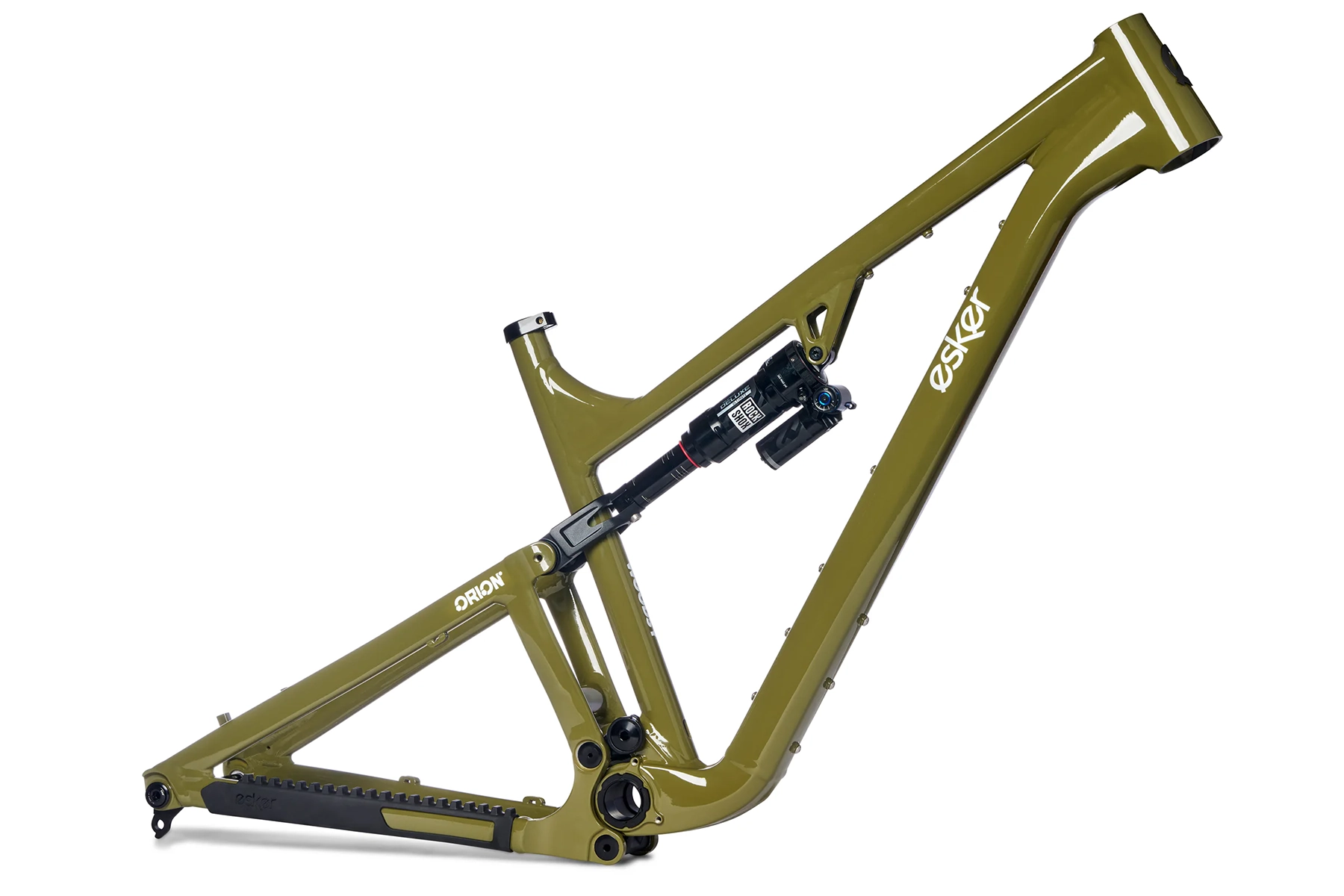
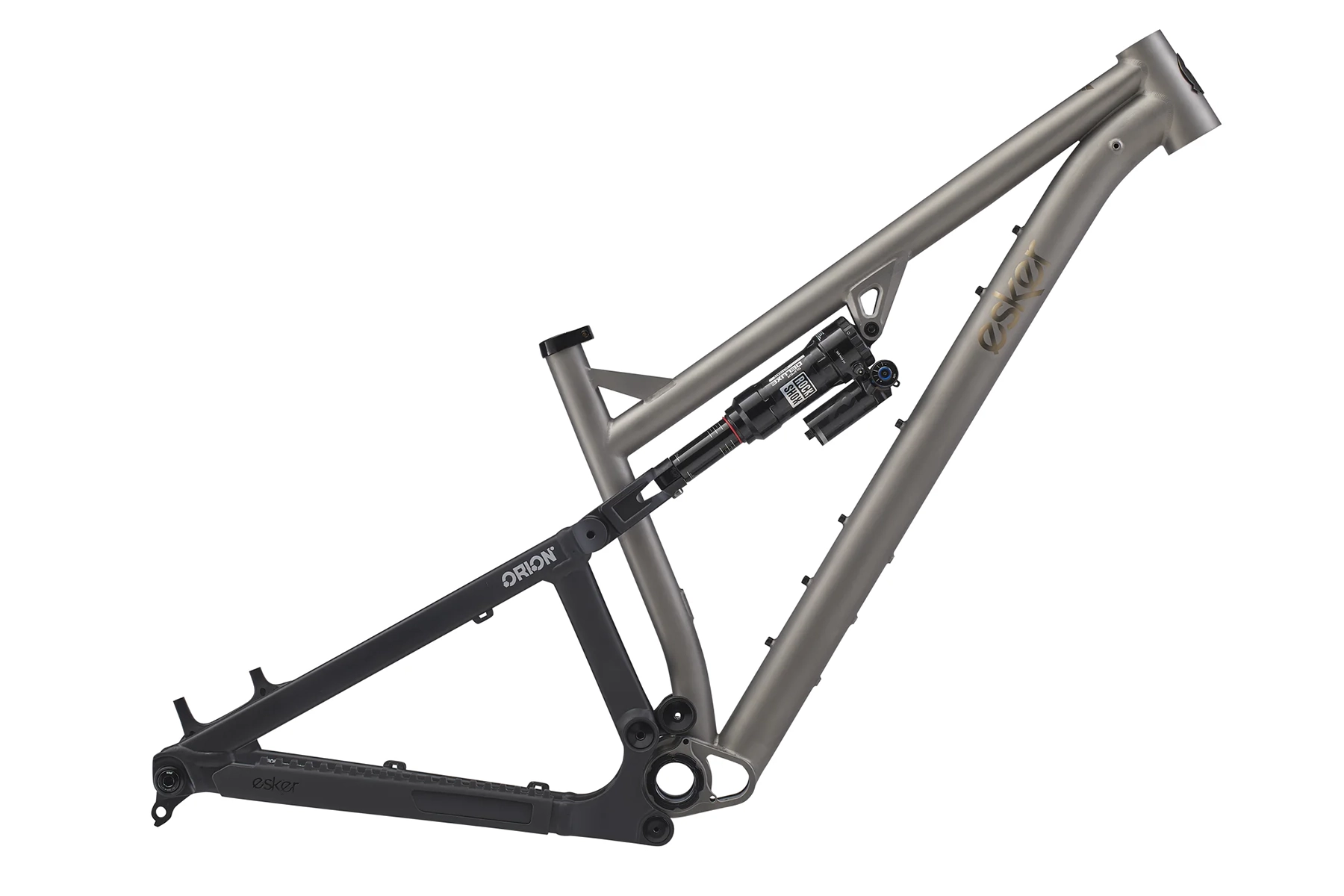
The Frame
Esker welds the Woodsy frames in Taiwan, with front triangles made with your choice of 6061-T6 Aluminum or Cold-Forged 3/2.5 Titanium; both share the same 6061-T6 swingarm. There are no flip chips for geometry adjustments, nor is there any fit adjustability — Esker has taken a simple, less complicated approach here.
The Orion Dynamics suspension platform is similar to the more common DW-link design in that it employs dual short links, but the overall layout is fairly different. The Orion system utilizes a lower link that rotates around the bottom bracket with the upper one tucked in above it. Esker says the dual small links work in concert with the concentric bottom bracket to provide controlled lateral stiffness and keep braking forces in check. Esker also claims it provides an efficient and stable pedaling response on all terrain, as well as good mid-travel square-edged bump compliance.
Because the lower link is concentric with the bottom bracket shell, there are some large bearings rotating around the threaded bottom bracket. The whole assembly is held in place by a proprietary left-hand threaded lock ring, which requires a special tool for service and is available on their website.
Esker has routed all the cables externally; some will like this, others will not, but there’s no denying that it simplifies brake, drivetrain, and dropper post installations, as well as service. Frame protection looks good, and there are water bottle mounts on the inside of the front triangle and the bottom side of the downtube. There are also some accessory mounts on the underside of the top tube.
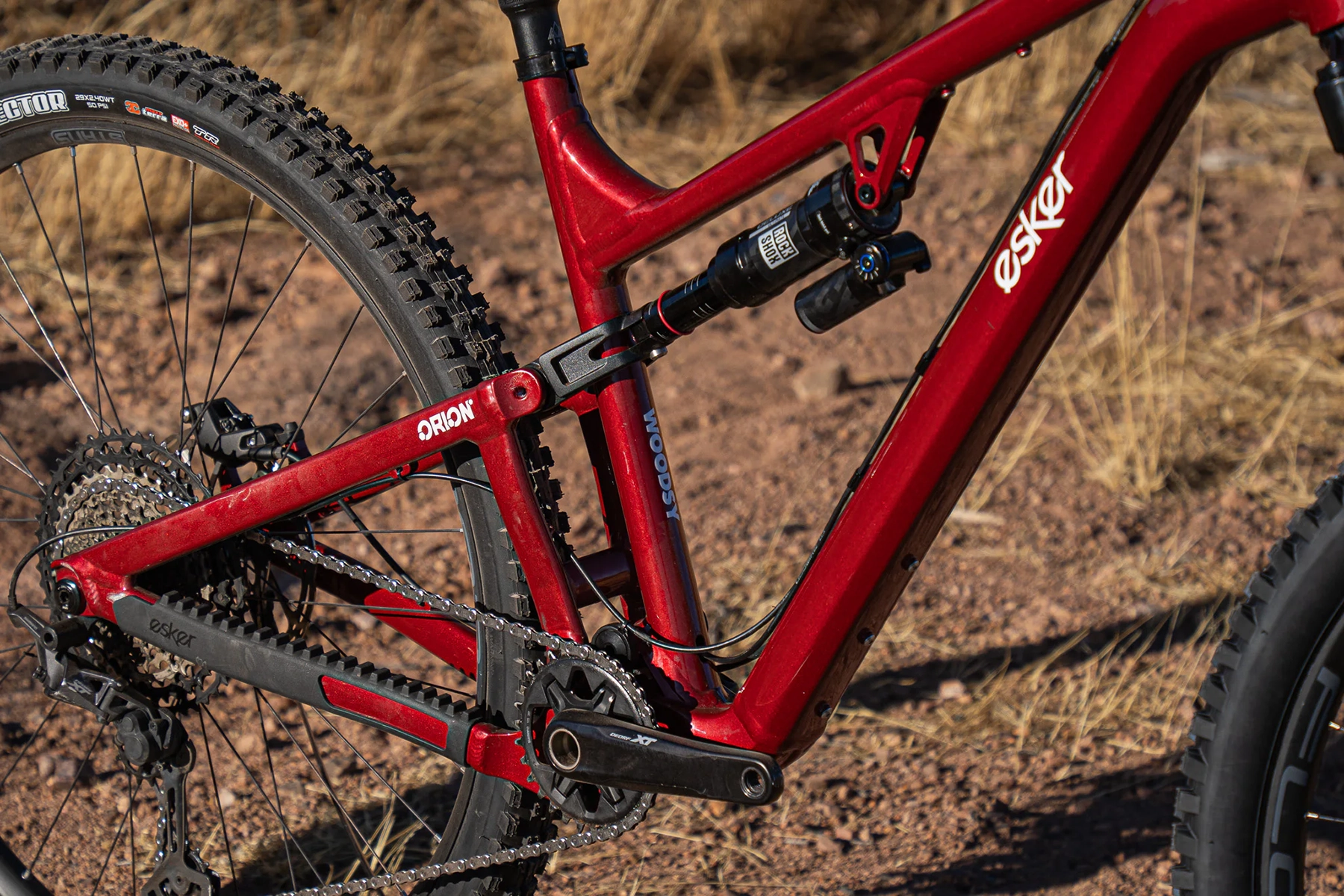
Fit & Geometry
Esker uses both numeric and nominal sizing for the Woodsy, and it comes in four sizes: S1/SM, S2/MD, S3/LG, and S4/XL. In comparison to Esker’s previous full-suspension offerings, the fit and geometry have changed considerably. The Rowl we tested had a fairly compact fit, and judging by the numbers, it looks like the Woodsy should be a good bit roomier. It has a notably long reach across the size range, with the size S3 (Large) coming in at a lengthy 501 mm. Now, fit is never reliant on just one number and is a combination of all of them, so we’ll have to see how it feels once we get on it, but I’ll admit it’s hard not to fixate on the reach number a little. That said, Esker does spec a short 35 mm stem on all sizes.
Esker made all-day comfort part of the design brief for the Woodsy, and in addition to the long reach, gave it a reasonably high stack height (646 mm, size Large) as a result.
The Esker Rowl had crazy short 425 mm stays, but given the Woodsy’s longer reach, it’s not surprising to see the rear end extended out to 440 mm — likely to improve fore/aft balance.
Finally, we love that Esker includes max seatpost insertion in their geometry chart, which is quite handy when deciding dropper post travel

The Builds
With a hybrid direct-to-consumer / dealer network sales model, it is possible to buy an Esker off a dealer’s sales floor or directly from the Esker website, shipped to your front door. For dealer sales, use Esker’s dealer locator on their website to find your closest dealer. Esker offers one base build ($4,000 for the aluminum frame, and $5,500 for titanium), and has customizable upgrade options for suspension, drivetrain, brakes, wheels, cockpit (dropper post, stem, and handlebar), headset, and seatpost clamp.
Esker’s online configurator is pretty slick and allows you to custom build your bike from the frame up. All the bikes ordered from the website are built to order in Minneapolis and are shipped almost fully built. Just install the front wheel, set up the cockpit, throw some sealant in the tires, and you’re pretty much ready to ride.
The base-level builds actually look really good, and given Esker prioritized making affordable mountain bikes, I’d say mission accomplished. Conversely, taking the mutt’s nuts approach and choosing the most expensive upgrades, it’s possible to ratchet the build price up to $8,224 when using the aluminum frame, and just shy of $10k for titanium. Overall, I think Esker has done a nice job of offering a wide range of options that should appeal to most riders.
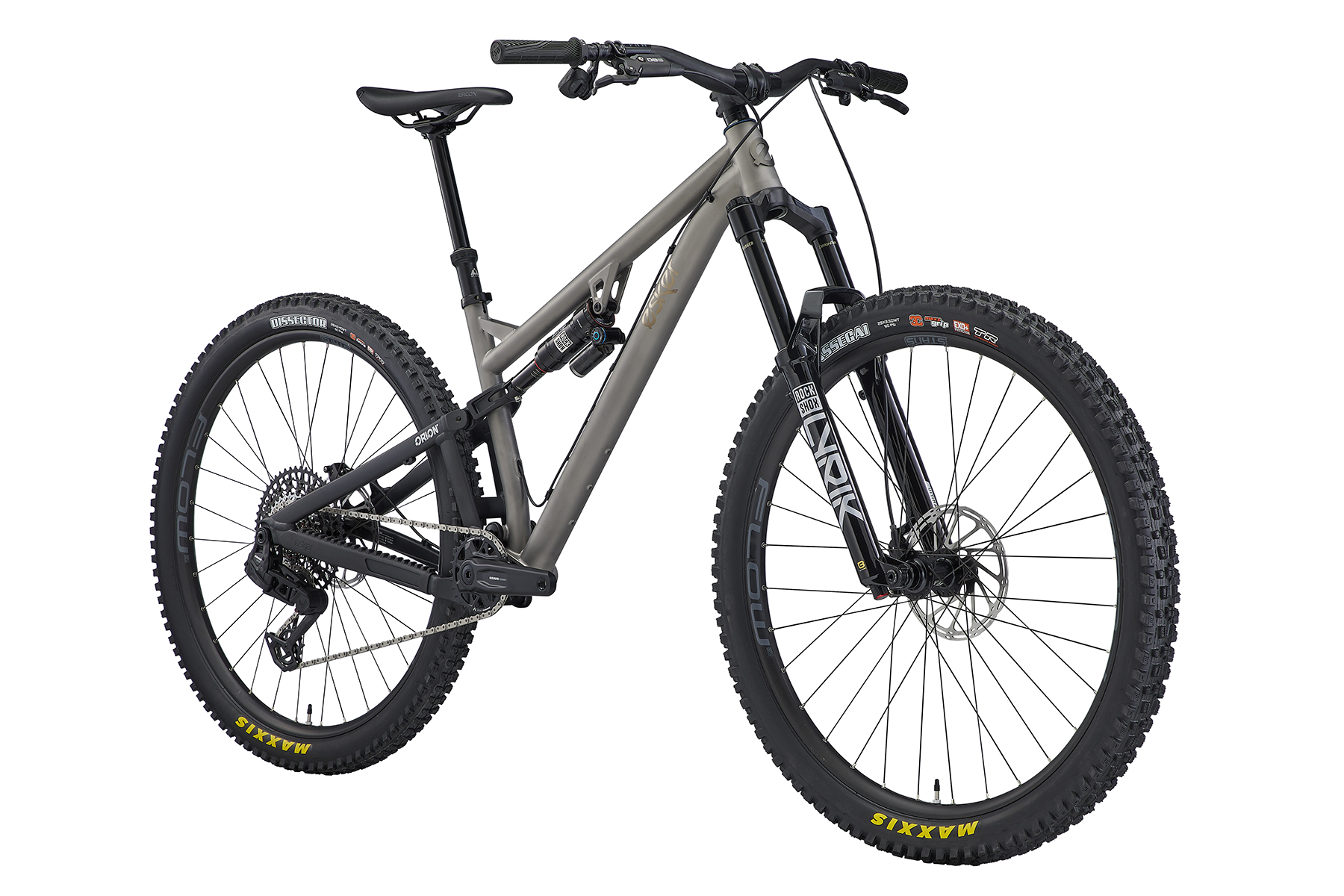
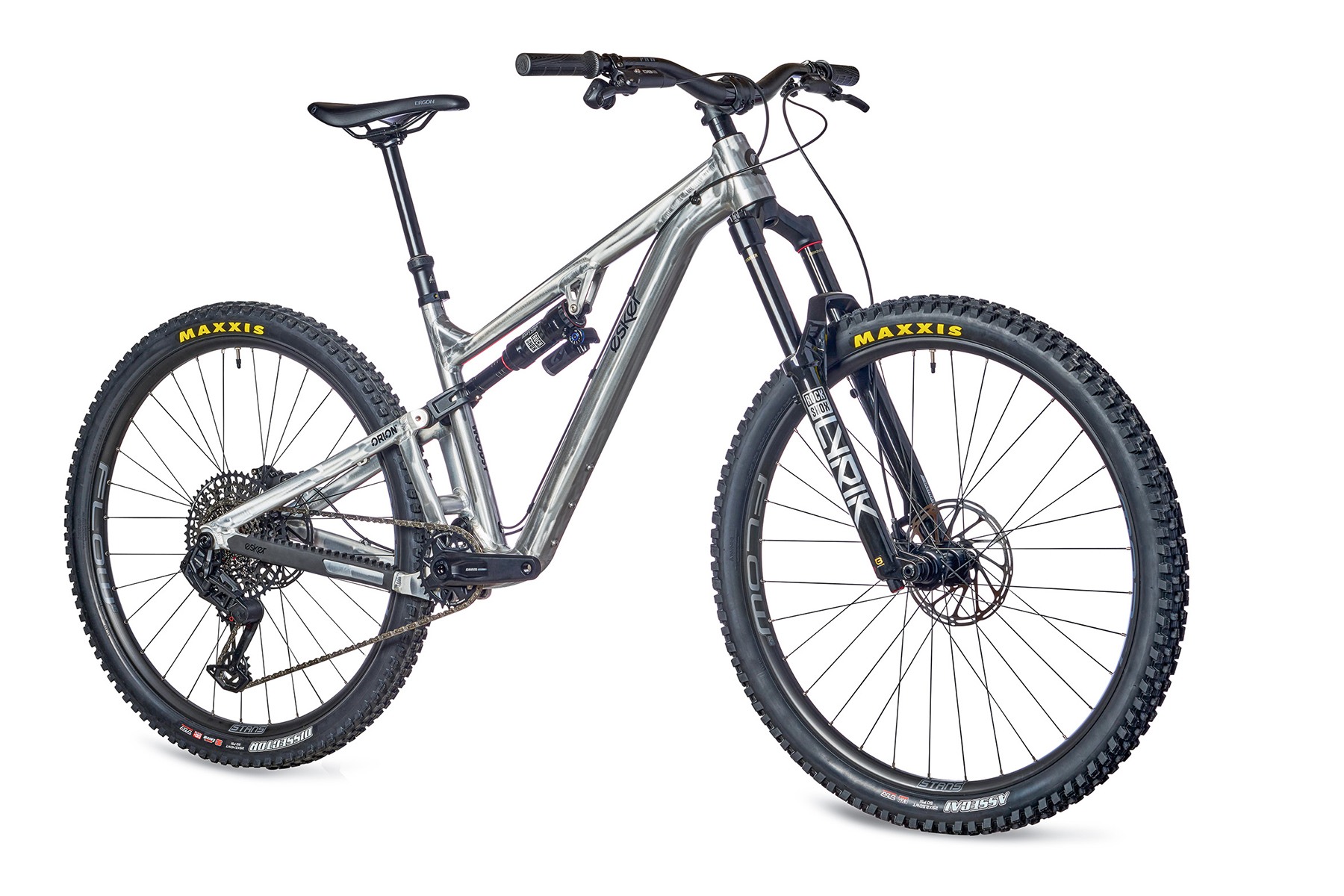
- Drivetrain: SRAM Eagle 90
- Brakes: SRAM DB8
- Fork: RockShox Lyrik Select
- Shock: RockShox Super Deluxe
- Wheels: Stans Flow S2 Alloy
- Dropper Post: PNW Loam Dropper (S1; 150 mm: S2-S3; 170 mm; S4; 200 mm)
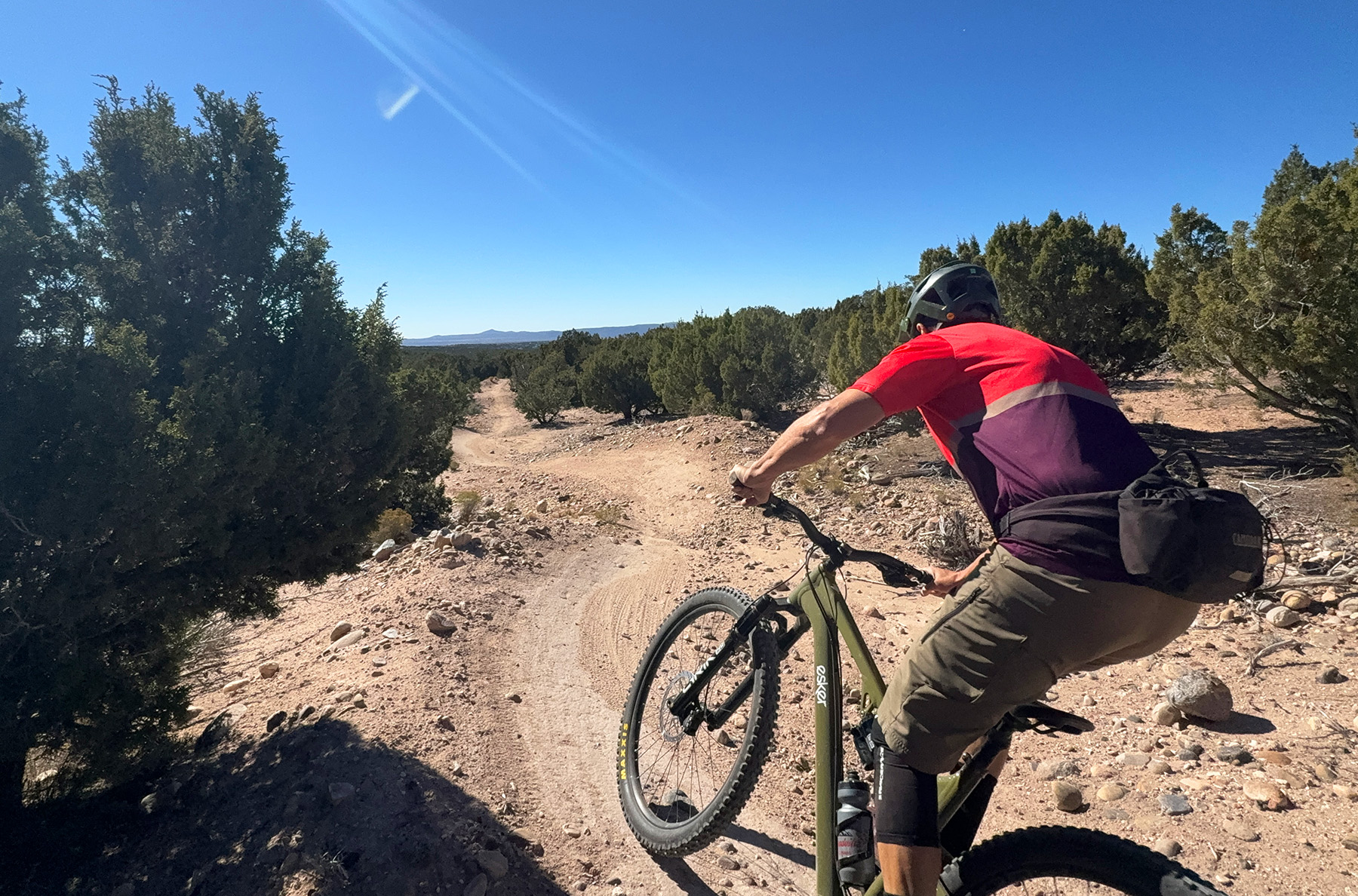
Full Review
We got along very well with Esker’s carbon fiber Rowl, so when they decided to stop making carbon fiber bikes in favor of metal bikes, we were a bit surprised and a little disappointed. Still, we were also looking forward to riding whatever new bike they came up with.
The Aluminum Woodsy features the same Orion suspension design that impressed us in the Rowl, but with a more versatile, All-Mountain-focused approach. Esker leans into their “Adventure by Bike” ethos, and on paper, the Woodsy looks to check that box, so let’s dive in and find out.
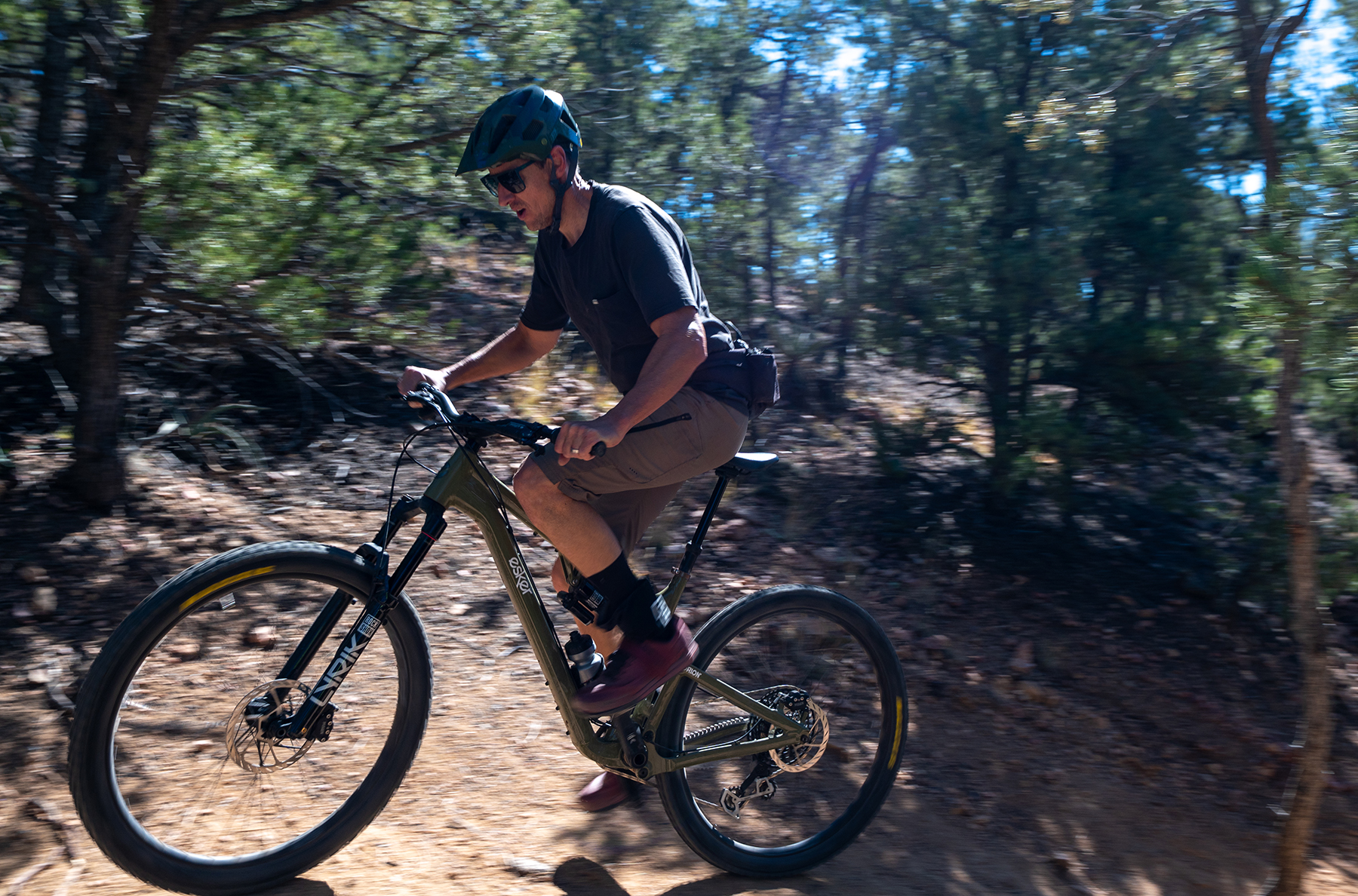
Fit & Sizing
Simon Stewart (6’, 170 lb / 183 cm, 74.8 kg): Esker’s size chart puts me directly in the middle of the sizing band for the size Large. However, there’s no doubt 501 mm of effective reach is on the long side for a size Large mountain bike, and due to my preference landing in the 475–485 mm, it had me taking a long look at the geometry chart to see if a size Medium made more sense. Going off my typically preferred reach range, the size Medium comes closer, at 473 mm.
Strictly going by the reach number alone, the size Medium looks tempting. However, when factoring in a steep-ish effective seat tube angle (77.5º) and a reasonably high stack height (646 mm), both of which can potentially shorten a cockpit, the size Large started to look like it could be a better fit. Without actually getting on the bike, it’s still a bit of an educated guess, but I still felt fairly confident that size Large was the right choice. Out of the box, I was happy that the fit did not feel too stretched out; instead, it was spot-on and quite comfortable — it turns out Esker’s size chart is also spot-on.
Thanks to relatively long (for a size Large) effective top tube measurement, there is plenty of room to move around on the Woody while seated, and there also feels like a decent amount of real estate between the wheels, giving the Woodsy a sizable sweet spot when descending while standing.
As a fan of high-ish stack heights, I was pleased when I first got on the Woodsy to find my seated riding position felt spot on. My hand height is about perfect, so there was no need to consider different handlebars. In fact, the only tweaks I made to the Woodsy to dial in the fit have been trimming the handlebars down to 780 mm (from 800 mm) and sliding the saddle forward a few millimeters on the rails.
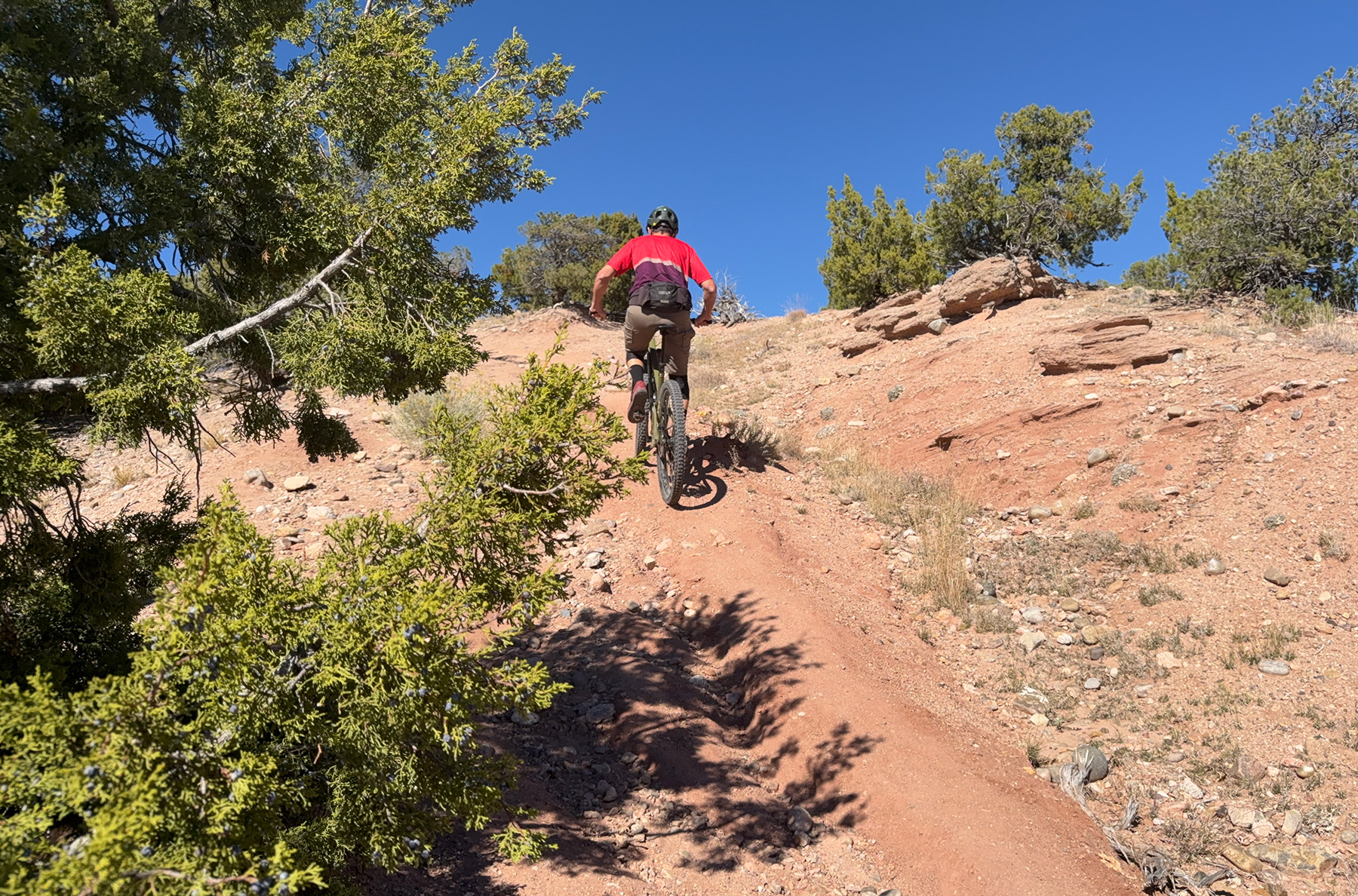
Climbing
The first things that stood out to me, going uphill on the Woodsy, were just how efficient and well-supported the suspension felt, as well as offering a ton of sensitivity to smoothly roll over rocks and roots while pedaling. It’s been a few years since I rode the Esker Rowl, which was my first time riding a bike with Dave Weagle’s Orion suspension design, and I still remember being impressed by its ability to seemingly isolate the pedaling forces from the rear wheel tracking up and over obstacles. Granted, that memory isn’t as clear a few years later, but I swear the Woodsy feels even better at it.
With the suspension remaining active while putting down the power, the Woodsy has heaps of traction. I was routinely surprised by how glued down it was when climbing super loose, steep, hard sections of trail. It doesn’t hurt that Esker gave the Woodsy a Maxxis Dissector rear tire, which I like for the typically loose-over-hard conditions I ride in. When climbing extra steep terrain, I think the medium-length 440 mm chainstays, in combination with the long reach and the high stack height, contribute to the Woodsy needing a decent forward weight shift to help keep the front end under control, causing me to have to slide farther forward on the saddle than I like. Moving the saddle forward on the rails a few millimeters made a noticeable difference, but a forward shift is still necessary, just not as far.
I find the Woodsy’s seated climbing position to be very comfortable, especially on the type of climbs where you’re locked into the same position for long periods of time, like the typical climbs in Colorado and New Mexico. Don’t get me wrong, there’s room to move around to change your position if needed, but I found I didn’t need to very often.
At 36.2 lbs / 16.4 Kg, the Woodsy isn’t light (nor did we expect it to be, given its aluminum frame and relatively burly build), so it doesn’t surge forward under hard pedaling efforts with the immediacy of more lightweight bikes such as the Spot Mayhem 140 or Rocky Mountain Instinct. However, it still responds nicely to those efforts, and once up to speed, it feels similarly quick. That is great because it helps keep me motivated to keep pushing hard rather than soft-pedaling with no intention to go fast, which is often the case on heavy bikes. Simply put, the Woodsy climbs like a much lighter bike.
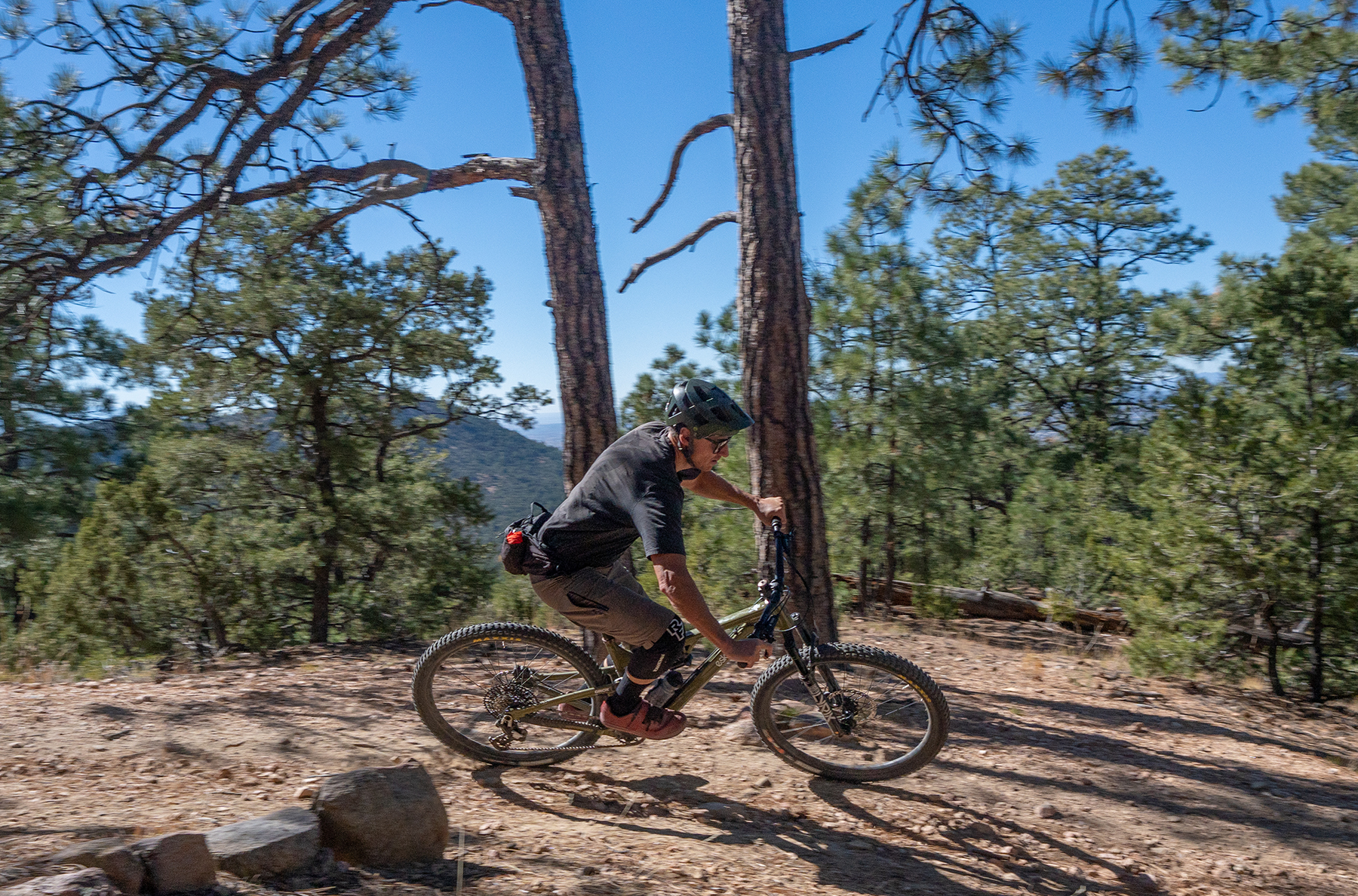
Descending
The Woodsy’s relatively long wheelbase (1,263 mm) gives it a more stable demeanor than many other bikes in its class, but, interestingly, I wouldn’t necessarily call it especially planted, which often goes hand in hand with stability. Yes, the suspension is very sensitive at the beginning of its travel and does a fantastic job of keeping the rear tire in contact with the trail. Deeper in the travel, though, that supple feel gives way to plenty of support and a touch of liveliness and poppiness that encourages you to get the Woodsy in the air when ridden with an active, playful style. It’s a nice combination that works well in rocky, rooty conditions, where the suspension’s sensitivity smooths out trail chatter and then delivers good support when things get rowdy. The Woodsy doesn’t lean as heavily in the playful direction as the Santa Cruz Bronson 5 does, and it’s not a high-speed plowing machine like the Norco Sight; instead, it strikes a nice balance in the middle.
There’s a lot of room to move around on the Woodsy with a pretty big sweet spot. I played around, shifting my weight bias between front, rear, and neutral, and settled on a slightly rearward weight bias when descending. I like how I can load the rear suspension in that position to get the front end up when needed, and thanks to the sizable sweet spot, the Woodsy isn’t fussy about a forward bias when cornering.
Not surprisingly, given the Woodsy’s stability, it’s not terribly agile. In tight terrain, its long wheelbase is noticeable. Thankfully, we don’t use a bike’s ability to clean ultra-tight switchbacks as a performance metric anymore, because the Woodsy wouldn’t fare so well.
Overall, I like how the Woodsy goes downhill. I typically prefer more playful bikes like the Bronson 5, but the Woodsy’s even distribution of talents like stability, sensitivity, support, liveliness, and a touch of playfulness make it a very well-rounded descender. To me, the Woodsy feels best when tackling steep, technical trails, where speeds are lower, and here its stability and active suspension really shine. Don’t get me wrong, it still likes to go fast, but its composure in weird, janky, off-camber conditions stands out.
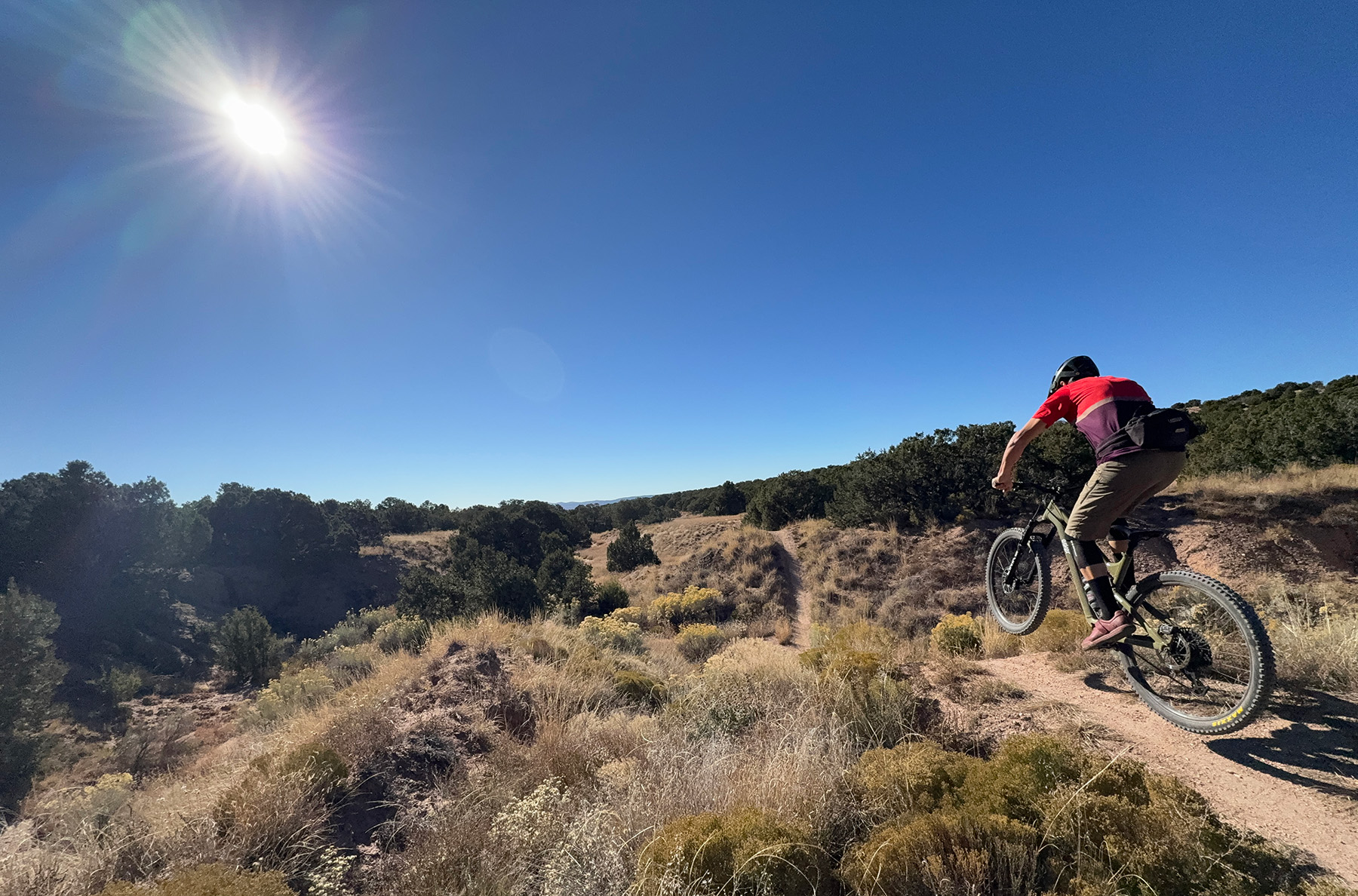
The Build
Esker offers one base build for the Woodsy with customizable upgrade options for suspension, wheels, drivetrain, brakes, and cockpit. One of the reasons Esker moved away from carbon fiber as a frame material is to offer their customers more value, and complete bikes start at $4,400 (including a 10% tariff surcharge). We spec’d our review bike with the goal of keeping the cost under $5,000, because we were interested in what kind of performance we could get for a modest budget.
With a $5k to work with, I looked at suspension and brake upgrades first. I view the drivetrain as a wear item, which is also susceptible to damage, so for me, the upgrade path makes more sense when it comes time to replace worn or damaged drivetrain parts. Wheels are tricky because I like fancy wheels, and they can make a tangible difference in ride quality and often weight. However, I think the cost-to-performance ratio is pretty high, typically resulting in relatively small gains for a lot of money.
I decided to upgrade the suspension from the RockShox Lyrik Select fork and Super Deluxe Select shock to a Lyrik Ultimate and Super Deluxe Ultimate. The Ultimate level fork and shock allow for more tuning via separate high and low-speed compression adjustments. I’ve been a big fan of SRAM’s Maven brakes since their release, so upgrading to them from the SRAM DB8 brakes was an easy decision. I’ve been impressed with the Mavens’ power and modulation, and they’ve become my brake of choice for pretty much anything from a Trail bike on up. With that said, I think the Mavens might be a wee bit sensitive to sub-optimal bleeding since I’ve had quite a few review bikes with Maven brakes that have needed a bleed out of the box. Lastly, I had a few dollars left under the $5k cap, so I opted for the carbon cockpit upgrade, which trades in the PNW alloy handlebar and generic stem for a PNW carbon bar and Industry Nine A35 stem.
All in, our Woodsy came to $4,950 at the time we ordered it (which, unfortunately, is now $5,350 thanks to the tariffs), and I’d say it strikes an excellent balance of performance and value. Looking back after 5 months of riding, I wouldn’t change a thing. The base build’s SRAM 90 drivetrain has been flawless, and honestly, as much as I like wireless electric shifting, it’s been liberating to have a bike with no bloody batteries onboard. The Stan’s Flow wheelset also stands out. I’ve had good luck with them on other bikes, and this is no exception — they’ve taken plenty of abuse, stayed true, and required no service.
The Woodsy does not have internal cable routing; instead, the brake line, derailleur, and dropper post cable are all routed on top of the down tube. Visually, I prefer the aesthetics of internal cable routing, and the whole easier to service the cables or install a rear brake argument isn’t a factor for me since I don’t find servicing internal cables difficult, and I like bleeding brakes. However, the Woodsy is one quite bike, with zero cable rattle, and that I can get behind.
We built a modestly priced Woodsy and the performance has exceeded our expectations. It’s worth noting that you should be interested in a higher-end build, you can tick all the upgrade boxes and ratchet the Woodsy’s price up $8,624. Esker has done a nice job of giving the consumer a lot of flexibility in how they spec their bikes
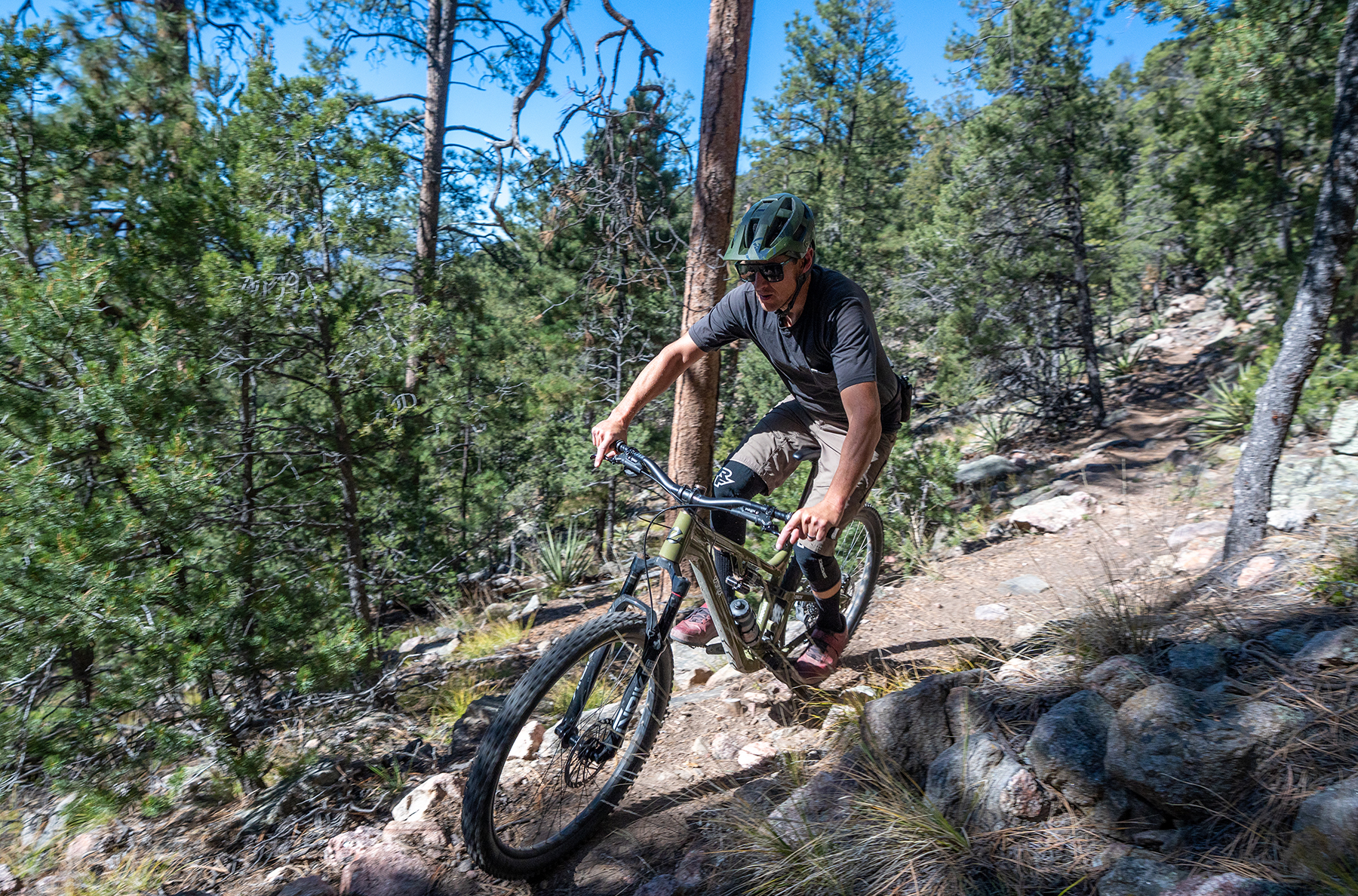
Who’s It For?
The Woodsy makes a lot of sense for folks looking for a versatile all-around mountain bike that encourages long rides and perhaps a bike packing trip here and there, but who also want a mountain bike that performs well when just out riding the local trails.
The aluminum frame has no flip chips or gimmicks, and is well-made with simple external cable routing and a very good suspension platform. Riders who prefer not to have adjustable suspension, and perhaps favor a metal frame that can take a lot of abuse, should put the Woodsy on their short list.
Bottom Line
Esker likes to say their bikes are “built for the backcountry,” and after putting loads of miles on the Woodsy, I tend to agree. Because to me, getting into the backcountry means long days in the saddle, and the Woodsy has been an ideal bike to do that on. Its comfortable riding position and plush, very efficient suspension make it a fine example of a bike that is easy to pedal while offering a smooth ride that lets you ride further and longer.
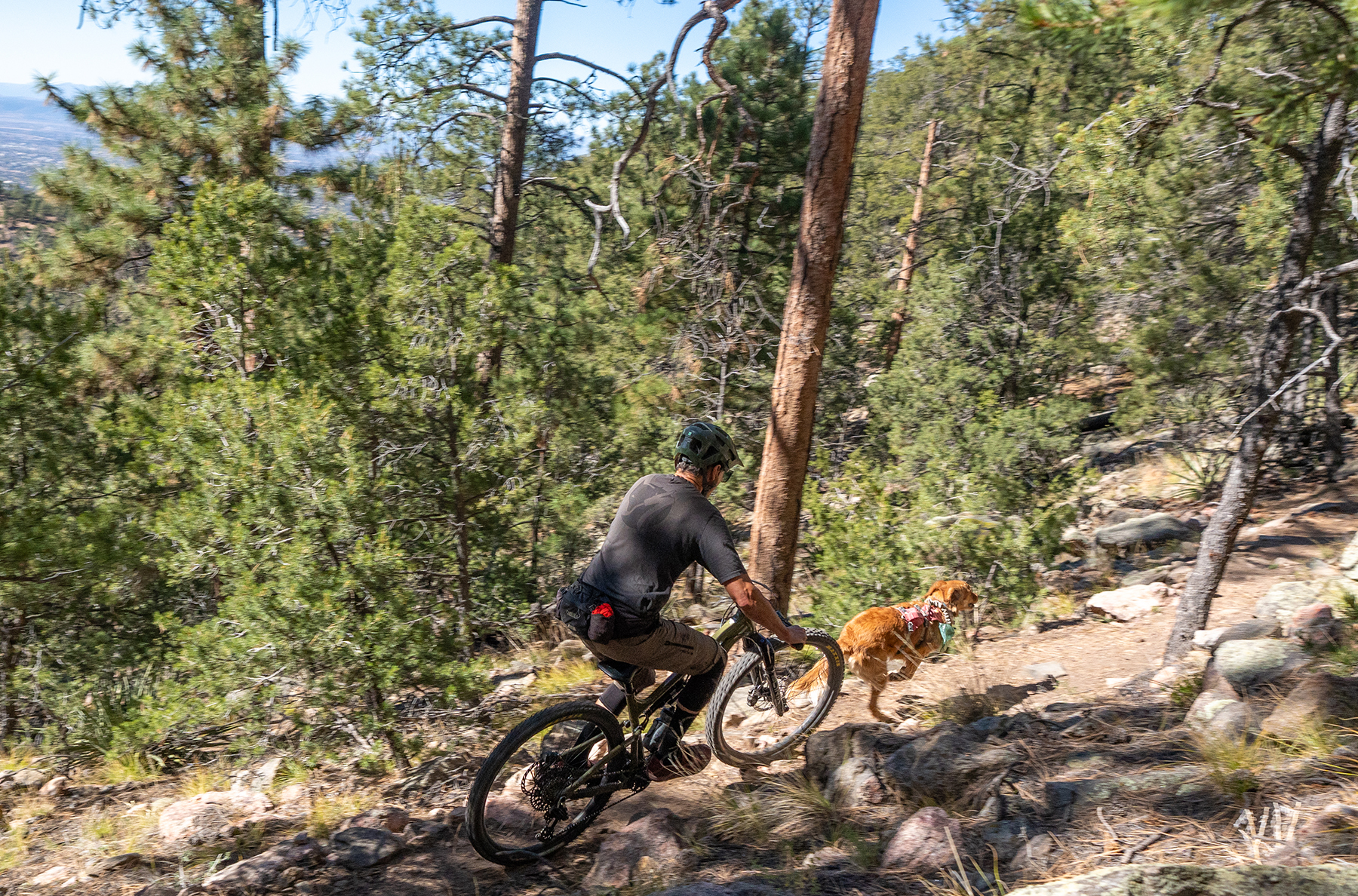
Deep Dive Comparisons
BLISTER+ members and those who purchase our Digital Access Pass can check out our Deep Dive comparisons linked below. Get our Digital Access Pass to view all our Deep Dives and Flash Reviews, or become a BLISTER+ member today to get access to that and a LOT more, including the best worldwide Outdoor Injury Insurance, exclusive deals and discounts on skis, personalized gear recommendations from us, and much more.

Deep Dive: Esker Woodsy
We compare the Esker Woodsy to the Santa Cruz Bronson 5, Spot Mayhem 140, Rocky Mountain Instinct, Salsa Blackthorn 145, and Knolly Fugitive 140.
Blister’s Flash Reviews and Deep Dives are accessible to those who purchase one of our paid subscriptions
To get our comprehensive Deep Dives and our initial, unfiltered reports on new gear, become a member and receive many other services, deals, and discounts.
If you’re already an active member, please log in.
(If you’re already logged in and a member in good standing and seeing this message in error, please refresh this page in your browser.)

Those are big frames! I’d say 1/2 to a full size bigger than many brands. For example, the Stumpy S6(XXL) and Hightower XXL have very similar stack and reach numbers to the XL Woodsy.
So we can certainly say they will be bigger when descending, and seated pedaling will also feel bigger, unless you can, and decide to, run your saddle much further forward on this bike.